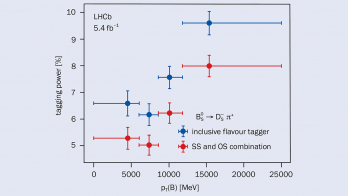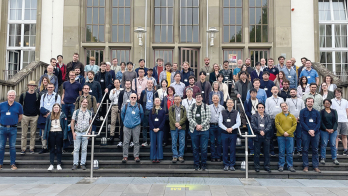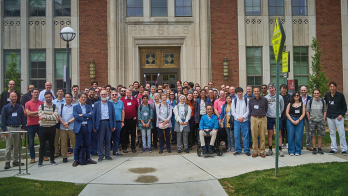
Experimenters from LHCb and theorists recently met at CERN to discuss the best ways to obtain the most out of the rich harvest of data from the LHC.
Despite the large size of modern particle-physics collaborations, every experiment faces issues that arise because resources do not match ambitions. For LHCb, the 70 journal papers the collaboration has submitted this year are only the tip of the iceberg of the interesting and often unique measurements that could be achieved. Because this iceberg might be able to fracture the hull of the Standard Model, it is essential to maximize the output of physics. This makes close communication with theorists crucial.
To facilitate such discussions, on 14–16 October LHCb held a workshop at CERN on “Implications of LHCb measurements and future prospects”. Following the tradition of two earlier meetings in the series, approximately 50 theorists from around the world joined members of the LHCb collaboration for intense discussions. Sessions covered charm mixing and CP violation, B mixing and CP violation, rare decays and “forward exotica”, including topics such as the production of top quarks and Higgs bosons in the LHCb acceptance. There was also a session dedicated to the interplay of LHCb results with, for example, studies of the Higgs boson and searches for supersymmetry at ATLAS and CMS.
One of the hottest topics concerned recent measurements by LHCb of the angular distribution of the decay products of B0 → K*0μμ transitions that have revealed tension with the prediction of the Standard Model (LHCb collaboration 2013). The observable known as P5´ – shown in the figure as a function of the dimuon invariant-mass squared (q2) – is particularly interesting. This parameter is sensitive to the modulation of the angular distribution that depends on the interaction between different operators contributing to the decay. It is therefore sensitive to the effects of physics beyond the Standard Model. Additionally, P5´ is insensitive at leading order to theoretical uncertainties related to the K* hadronic form factor. However, corrections from higher-order terms introduce residual uncertainty. The tension in the data can be reduced if the uncertainty is allowed to be larger than original estimates – an observation that sparked a debate about the best estimate of the size of the so-called “power corrections”.
Several key points emerged from the discussion. On the theory side, further studies can help to understand the uncertainties in the form factor. Experimentally, improved analyses with the full LHCb data sample of 3 fb–1 are keenly anticipated: with this large data sample and exploiting the power of the LHCb particle identification system, it might be possible for the first time to perform a full angular analysis that also separates the subtle Kπ S-wave component from the K* signal. Moreover, continuing discussions between theorists and experimenters will be needed to understand which of several different approaches to control the uncertainties is the most sensitive to physics beyond the Standard Model.
For more about the workshop, see http://indico.cern.ch/conferenceDisplay.py?ovw=True&confId=255380.







